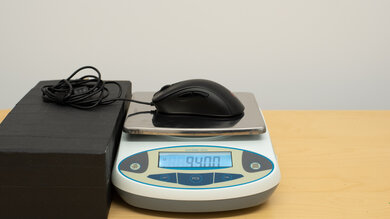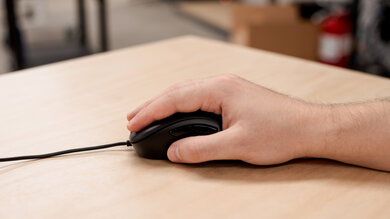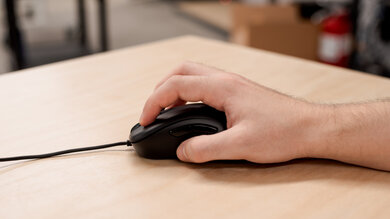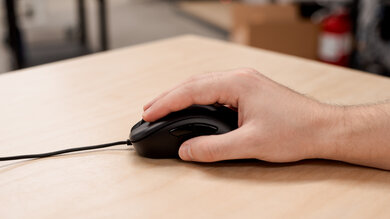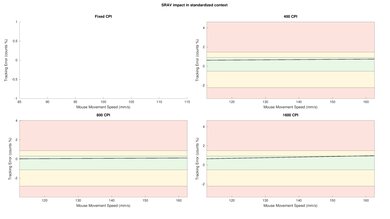The BenQ ZOWIE EC2 is a good gaming mouse that's somewhat light. Its high back and slightly curved design should feel comfortable for right-handed people, especially if used in a palm or claw grip. The click latency is low and should feel responsive while gaming, and the CPI range is wide, although its maximum CPI isn't as high as some other gaming mice. Unfortunately, there's no companion software, so you can't customize any of the sensor settings or reprogram the buttons, and there are no RGB lighting zones. We only tested the medium variant, although we expect most of our results to apply to the large variant as well, except for the weight and grip type recommendation.
Our Verdict
The BenQ ZOWIE EC2 is a disappointing office mouse. Although it feels comfortable to use and it's fully compatible with Windows and macOS, the build quality is only decent. It only has two side buttons for forward and back, but you can't reprogram them. The scroll wheel can't be unlocked for infinite scrolling, and there are no wireless options.
-
Feels comfortable.
-
Fully compatible with Windows and macOS.
-
Only decent build quality.
-
No customization software.
-
Only two side buttons.
-
No wireless connectivity options.
The BenQ ZOWIE EC2 is good for FPS gaming. Its click latency is low and should feel responsive, and the slight curve of its design should make it comfortable to use. It's somewhat light, but its cable isn't very flexible and its build quality is only decent due to some flexing at the button of the mouse.
-
Low click latency.
-
Feels comfortable.
-
Fully compatible with Windows and macOS.
-
Somewhat lightweight.
-
Only decent build quality.
-
No customization software.
The BenQ ZOWIE EC2 isn't designed for MMO gaming. It only has two side buttons, which is much less than dedicated MMO mice. You can't reprogram any of the inputs or customize its CPI settings. Its build quality is only decent since lightly squeezing the bottom activates one of the size buttons. However, it feels comfortable to use and its click latency is low.
-
Low click latency.
-
Feels comfortable.
-
Fully compatible with Windows and macOS.
-
Only decent build quality.
-
No customization software.
-
Only two side buttons.
The BenQ ZOWIE EC2 is a good option for fans of ultra-light gaming mice. Its click latency is low and should feel responsive, and the maximum polling rate is very high. It feels comfortable to use and the feet glide well, but the cable is quite kinky. Even though it's not designed for ultra-light gaming and it's heavier than some other mice, it's still somewhat light.
-
Low click latency.
-
Feels comfortable.
-
Fully compatible with Windows and macOS.
-
Somewhat lightweight.
-
Significantly heavier than ultra-light mice.
-
Only decent build quality.
-
No customization software.
The BenQ ZOWIE EC2 is bad for travel since it's a wired-only mouse with no wireless options. It's designed to be used with your at-home gaming setup.
-
Feels comfortable.
-
Only decent build quality.
-
No wireless connectivity options.
- 5.7 Office/Multimedia
- 7.3 Video Games (FPS)
- 6.3 Video Games (MMO)
- 7.1 Ultra-Light Gaming
- 4.9 Travel
- Updated Jul 25, 2024: We've added a link to the newly-reviewed GLORIOUS Model D 2 to the Click Latency section of this review.
- Updated Sep 28, 2022: We've converted this review to Test Bench 1.2. This update simplifies our Weight test and expands on our CPI test from Test Bench 1.1, resulting in changes to test results in both sections. For more details, you can see our complete changelog here.
- Updated Sep 21, 2022: We've converted this review to Test Bench 1.1. This update revamps our Click Latency test and results in changes to test results. For more details, you can see our full changelog here.
- Updated Nov 09, 2020: Review published.
- Updated Nov 03, 2020: Early access published.
- Updated Oct 26, 2020: Our testers have started testing this product.
- Updated Oct 23, 2020: The product has arrived in our lab, and our testers will start evaluating it soon.
- Updated Oct 18, 2020: We've purchased the product and are waiting for it to arrive in our lab.
- Updated Oct 12, 2020: The product has won our suggestion poll, so we'll buy and test it soon.
Differences Between Sizes And Variants
We tested the BenQ ZOWIE EC2, which is a medium-sized mouse. There's also a large-sized variant of this mouse called the BenQ ZOWIE EC1. You can see the label of our unit here.
Compared To Other Mice
The BenQ ZOWIE EC2 is a good gaming mouse if you want a simple design with no RGB lighting. Its CPI range isn't as wide as other gaming options, but it should be high enough to please casual gamers. Unfortunately, it doesn't come with customization software, so you're limited to the presets already on the mouse. Some people may find it relatively pricey for its performance.
For other options, see our recommendations for the best mouse, the best wired mouse, and the best gaming mouse.
The Logitech G Pro Wireless is better than the BenQ ZOWIE C2. The Logitech is lighter, easier to travel with since it has no cable, has a wider CPI range with a more consistent sensor, and customization software. However, the BenQ might provide better value for some people.
The BenQ ZOWIE EC3-C is a new, smaller-sized mouse in the ZOWIE EC series and part of its C-version update. Compared to the EC2, the EC3-C is slightly shorter and much lighter, and it feels significantly better built. It has a flexible, paracord-like cable instead of the rubber cable on the EC2, and the mouse end of the cable is angled upwards to prevent drag. Its smaller size is better suited for small hands using a claw grip. On the other hand, the EC2's larger size accommodates extra-large hands better for a palm grip. Also, its click latency is lower. Otherwise, both mice use the same sensor and are both limited to four preset CPI settings.
The Logitech G403 HERO is better than the BenQ ZOWIE EC2. The Logitech feels better built, has a wider and more customizable CPI range, and its click latency is slightly lower. Also, unlike the BenQ, the Logitech's logo and scroll wheel have RGB zones, and it comes with outstanding software to customize the buttons and sensor settings. However, the BenQ's mouse feet glide better than the Logitech.
The GLORIOUS Model D is better than the BenQ ZOWIE EC2. The GLORIOUS has a wider and adjustable CPI range, a slightly lower click latency, RGB lighting, and software to remap the buttons. On the other hand, the BenQ is fully compatible with macOS.
The Razer DeathAdder V2 is better than the BenQ ZOWIE EC2. The Razer feels better built, it has a wider CPI range, a lower lift-off distance, and it comes with customization software. However, the BenQ is fully compatible with macOS.
The BenQ ZOWIE EC2 is an older, medium-sized version in the BenQ ZOWIE EC-series, while the BenQ ZOWIE EC1-C is a newer, large-sized version with several improvements. The EC1-C is somewhat lighter and feels much better built. It also has a more flexible cable, better quality mouse feet with rounded edges, and a lower minimum lift-off distance. Both mice are suitable for all grip types, but the EC2 is recommended for small hands using a palm grip, while the EC1-C isn't.
The BenQ ZOWIE EC1 and the BenQ ZOWIE EC2 are very similar gaming mice with right-handed ergonomic shapes but different sizes. The EC1 is the larger of the two. It feels sturdier, has feet with rounded edges, and a more flexible cable. It's suitable for all grip types, but those with medium hands may not reach all buttons using a fingertip grip, and it isn't suitable for small hands, regardless of grip type. On the other hand, the EC2 is slightly lighter and is well-suited for all hand sizes using a palm grip. However, those with small hands likely won't be able to comfortably reach all buttons using a claw grip, and those with medium or small hands may not be able to reach all buttons using a fingertip grip.
The BenQ ZOWIE EC2 and the BenQ ZOWIE FK2-B are wired gaming mice with similar performance but different shapes and sizes. The EC2 has an ergonomic shape for right-handed users. It's well-suited to all grip types, but those with smaller hands may not be able to reach all the buttons using a claw or fingertip grip. On the other hand, the FK2-B has an ambidextrous design with a low profile. It's well-suited for all grip types and nearly all hand sizes, though those with smaller hands may not be able to reach all buttons with a fingertip grip.
The BenQ ZOWIE EC2 and the Vaxee ZYGEN NP-01 are comparable wired gaming mice, but the Vaxee is better overall. The Vaxee has a lighter weight, a more flexible and better quality cable, smoother-gliding mouse feet, and a lower lift-off distance. Otherwise, neither mouse has customization software to reprogram buttons or adjust the CPI, and you can only cycle between four CPI presets on each.
The G-Wolves Skoll SK-S ACE Edition is an excellent ultra-light gaming mouse, while the BenQ ZOWIE EC2 is a good FPS gaming mouse. The G-Wolves is significantly lighter and feels better built. It has a more flexible cable, smoother-gliding mouse feet, and a lower lift-off distance. Also, the G-Wolves has customization software, unlike the BenQ, and you can reprogram buttons and adjust the CPI precisely. On the other hand, the BenQ has slightly lower click latency.
In most respects, the SteelSeries Prime+ is a better wired gaming mouse than the BenQ ZOWIE EC2. The Prime+ is significantly lighter, has a more flexible cable, mouse feet that glide more smoothly, and an OLED screen on the underside that you can use to adjust settings without the software. It also has a much wider CPI range, an adjustable CPI, a lower lift-off distance, and companion software for customization. It's ideal for a claw grip for all hand sizes. Comparatively, the BenQ has a much lower click latency and is ideal for a palm grip for all hand sizes.
The BenQ ZOWIE EC2 and the Microsoft Pro IntelliMouse are good wired gaming mice with ergonomic right-handed shapes. The BenQ is significantly lighter and has much lower click latency. Comparatively, the Microsoft feels sturdier, has a much wider CPI range, an adjustable CPI, and a lower lift-off distance. It also has companion software for customization, which the BenQ lacks. The BenQ is well-suited for all hand sizes using a palm grip, but otherwise, both mice are better-suited for larger hands using other grip types.
The Pwnage Ultra Custom Wireless Ergo and the BenQ ZOWIE EC2 are nearly identical in size and shape, but the Pwnage is a better gaming mouse overall. The BenQ is a wired-only mouse. On the other hand, the Pwnage is significantly lighter, and you can connect it with its charging cable or wirelessly with its USB receiver. The Pwnage also includes several modular pieces that you can use to alter the look and feel of the mouse. Additionally, it has mouse feet that glide more smoothly, a wider CPI range, an adjustable CPI, a lower lift-off distance, and customization software, which the BenQ lacks.
The BenQ ZOWIE EC2 and the BenQ ZOWIE FK1+-B are wired gaming mice with similar performance but different shapes and sizes. The EC2 has an ergonomic right-handed design. On the other hand, the FK1+-B has an ambidextrous low-profile shape with less palm support. Both mice are well-suited for larger hands, but the EC2 is suitable for a palm grip, regardless of hand size.
The BenQ ZOWIE EC2 and the BenQ ZOWIE ZA11-B are both simple gaming mice. The EC2 has a slight right-handed slant, whereas the ZA11-B has an ambidextrous shape. Both mice use the same sensor, which has a very narrow CPI range and a fairly low minimum lift-off distance. Neither have customization software, so you can't adjust the CPI, remap the buttons, or set macros. The EC2 may be a better choice for gaming since its click latency is lower.
The Vaxee ZYGEN NP-01S and the BenQ ZOWIE EC2 have similar, straightforward shapes with no RGB lighting. Neither comes with customization software to reprogram the keys or adjust the settings, and you can only cycle through four CPI presets and three polling rates. However, you can also cycle between three debounce times on the Vaxee, and it also has a lower minimum lift-off distance and smoother-gliding mouse feet than the BenQ.
The BenQ ZOWIE EC2 and the SteelSeries Prime Mini are wired gaming mice with similar shapes, but the SteelSeries has better overall performance. The SteelSeries is significantly lighter and feels sturdier. It also has a more flexible cable and better quality mouse feet. Performance-wise, it has a lower lift-off distance and a much wider CPI range. You can also precisely adjust the CPI by increments of 50, while you can only choose between four preset CPI settings on the BenQ. Additionally, the SteelSeries has customization software, which the BenQ lacks. On the other hand, the BenQ has a more consistent sensor.
The BenQ ZOWIE EC2 and the Sharkoon Light² 200 have a very similar shape that's best suited for a palm or claw grip for most hand sizes. The Sharkoon has a honeycomb cutout design on its sides and palm rest that makes it much lighter, and it also comes with an alternate solid palm rest if you prefer. Also, it has a lower lift-off distance and a wider CPI range with a CPI that you can adjust in precise increments. You can reprogram all the buttons using the dedicated software, and the CPI switching button is on the top of the mouse instead of on the underside like the BenQ, making it easier to adjust your CPI mid-game. The BenQ has a more straightforward design with no RGB or customization software and has much lower click latency.
The BenQ ZOWIE EC2 and the Gigabyte AORUS M5 are both wired gaming mice. The BenQ has lower click latency and a more consistent sensor, and it weighs much less. On the other hand, the Gigabyte feels better built, and it comes with customization software, which some people may prefer. It has an adjustable CPI within a much wider range, programmable buttons, and five 2.5g weights to adjust the weight and its distribution. Both mice are suitable with any grip type for most hand sizes, but people with medium hands using a fingertip grip may feel more comfortable with the Gigabyte.
The SteelSeries Prime Mini Wireless is an impressive wireless gaming mouse, while the BenQ ZOWIE EC2 is a very good wired gaming mouse. The SteelSeries is lighter and feels sturdier. It also has mouse feet that glide more smoothly and, despite being a wireless mouse, has a more flexible charging cable. Performance-wise, it has a much wider CPI range and a lower lift-off distance. It also has customization software compatible with Windows and macOS, which the BenQ lacks. On the other hand, the BenQ has a more consistent sensor and somewhat lower click latency, but it only has four default CPI presets.
The BenQ ZOWIE EC2 and the EVGA X17 are both good, wired gaming mice. The EVGA feels sturdier and has a thumb rest. It also has three additional buttons, including an extra side button and a scroll wheel with L/R tilt buttons. Performance-wise, it has a much wider CPI range, a CPI you can set precisely, a lower lift-off distance, and a higher maximum polling rate. It also has RGB lighting and customization software, which the BenQ lacks. The BenQ is somewhat lighter, has better click latency, and has a much more consistent sensor.
The Pulsar Xlite V2 and the BenQ ZOWIE EC2 are gaming mice with very similar shapes but are otherwise quite different. The Pulsar is a wireless model that's much lighter with significantly better sensor performance and click latency. It also feels sturdier overall. Its body has perforated pill-shaped cutouts and a very minimal baseplate design to reduce overall weight. On the other hand, the BenQ has a solid plastic shell.
The Fnatic FLICK 2 and the BenQ ZOWIE EC2 are both good wired gaming mice. The Fnatic feels sturdier and has a more flexible cable. It also has a wider CPI range, and you can adjust the CPI by increments of 100, while you can only cycle between four preset CPI settings on the BenQ. The Fnatic also has customization software, which the BenQ lacks. On the other hand, the BenQ is marginally lighter and has mouse feet that glide smoother, though they have sharp edges. The BenQ also has significantly lower click latency.
The G-Wolves Hati HT-S ACE Edition is a better, wired gaming mouse than the BenQ ZOWIE EC2. The G-Wolves is nearly half of the weight of the BenQ and feels sturdier. It also has a more flexible cable and mouse feet that glide more smoothly. Performance-wise it has a lower lift-off distance, a wider CPI range, and you can precisely adjust the CPI, while the BenQ only has four CPI presets. It also has customization software which the BenQ lacks. Both mice have nearly identical click latency and are well-suited for all grip types. However, the BenQ is better-suited for larger hands, while the G-Wolves is more accommodating for smaller hands.
The EQEOVGA D10 RGB has a very similar shape to the BenQ ZOWIE EC2, but the EQEOVGA performs better overall. THE EQEOVGA is much lighter and has a more flexible cable. It also has a wider CPI range, a CPI you can adjust by increments of 100, and customization software, which the BenQ lacks. On the other hand, the BenQ has a marginally more consistent sensor and lower click latency, though most people are unlikely to notice a difference. Unfortunately, it only has four default CPI presets.
The BenQ ZOWIE EC2 and the Redragon COBRA M711-FPS are wired gaming mice with comparable performance. The BenQ is somewhat lighter and has mouse feet that glide more smoothly. It also has lower click latency. On the other hand, the Redragon feels somewhat sturdier and has a wider CPI range. It has three buttons behind the scroll wheel, which adjust CPI and lighting settings by default, whereas the BenQ has no buttons behind its scroll wheel. The Redragon also has customization software, which the BenQ lacks. Both mice are suitable for all grip types and almost all hand sizes.
The Pulsar Xlite is a better wired gaming mouse than the BenQ ZOWIE EC2. The Pulsar is significantly lighter and feels much sturdier. It has a much more flexible cable and mouse feet that glide more smoothly. It also has a wider CPI range, an adjustable CPI, and a lower lift-off distance. Additionally, it has customization software, which the BenQ lacks. On the other hand, the BenQ ZOWIE only has four default CPI settings. Both mice are suitable for all grip types, but the Pulsar is accomodating to a wider range of hand sizes.
The BenQ ZOWIE EC2 is a somewhat better gaming mouse than the ASUS TUF Gaming M3. It has a slightly more flexible cable, mouse feet that glide more smoothly, and a much lower click latency. Unfortunately, it only has four default CPI presets. Comparatively, the ASUS is lighter and feels sturdier. It also has a wider CPI range and an adjustable CPI. It has companion software for customization, which the BenQ lacks, but it's only compatible with Windows. Both mice are suitable for all grip types, but the BenQ is better-suited for larger hands, while the ASUS better accommodates smaller hands.
The BenQ ZOWIE EC2 and the BenQ ZOWIE FK1-B are very similar wired gaming mice with comparable performance but different shapes. The ZOWIE EC2 has a right-slanted ergonomic shape and a more flexible cable. On the other hand, the FK1-B has a low-profile, symmetrical shape, a sturdier-feeling build, and mouse feet with rounded edges. Both mice are very well suited for palm and claw grips, but only those with large hands will likely find a fingertip grip comfortable.
The Vaxee OUTSET AX and the BenQ ZOWIE EC2 are wired gaming mice with similar designs, but the Vaxee is a better mouse overall. The Vaxee has a significantly sturdier-feeling build quality, it's lighter, it's slightly taller and wider, and it has textured surfaces on the L/R click buttons. It also has better cable and mouse feet, lower click latency, and a lower lift-off distance. Both mice lack companion software, and they only have four default onboard CPI settings.
The Razer DeathAdder Elite is better than the BenQ ZOWIE EC2. The Razer feels better built, more comfortable, and has RGB lighting on its scroll wheel and logo. Also, the Razer has a much wider CPI range that you can adjust very precisely, and it comes with software for customizations. However, the BenQ has a lower click latency.
The BenQ ZOWIE S2 is a better gaming mouse than the BenQ ZOWIE EC2. The S2 feels better built, and its feet glide better since it has no sharp edges. Also, its sensor is more consistent than the EC2. However, the EC2 feels more comfortable, its cable is more flexible, and its click latency is marginally lower.
The Anker Gaming Mouse is better than the BenQ ZOWIE EC2. The Anker feels better built and has a wider CPI range, and it comes with software that lets you reprogram its buttons and customize its settings. However, the BenQ is better suited for larger hands than the Anker is, and its click latency is much lower.
Test Results
The BenQ ZOWIE EC2 is a simple, matte black mouse. It has a slight curve designed for right hands, a high rounded back, and two shiny buttons on its left side. The branding on the back is red and not backlit. Unlike most gaming mice, it doesn't have any RGB zones. If you're looking for a mouse that shares a similar design language and shape but has better performance, check out the Vaxee OUTSET AX.
The build quality is only decent. Although the top portion feels solid, the bottom exhibits a lot of flex, and one of the side buttons can be activated just by squeezing below it without much force. The side buttons feel mushy and go deep into the mouse when pressed. On the upside, the PTFE feet are good and glide smoothly. If you're looking for a lighter gaming mouse with an even sturdier-feeling build quality, check out the Endgame Gear XM1r.
It's somewhat light, and there are no weight optimization options. We expect the large variant to be heavier. For a similarly-shaped mouse with a lighter weight, consider the Vaxee ZYGEN NP-01 or the G-Wolves Skoll SK-S ACE Edition.
The BenQ ZOWIE EC2 feels comfortable to use, thanks to its slightly curved design. The side buttons are well-placed and any hand size shouldn't have problems reaching them with a palm grip. Due to its size, people with smaller hands might struggle to use it comfortably with a claw or fingertip grip. There's also a large variant of this mouse designed for larger hands, the BenQ ZOWIE EC1. For a similar mouse with grippy rubber side panels, check out the Cooler Master MasterMouse MM530 or the Fnatic FLICK 2. Or, for a mouse with an ambidextrous design, check out the BenQ ZOWIE ZA11-B, or the SteelSeries Sensei 310.
The BenQ ZOWIE EC2 is a wired-only mouse so it can't be used wirelessly.
The rubber cable isn't very flexible and it retains kinks from the packaging. However, it's slightly better than the cable on the BenQ ZOWIE S2. For an updated version of this mouse with a much better cable, check out the BenQ ZOWIE EC3-C.
It has two side buttons and two buttons on the bottom of the mouse to adjust the CPI and the polling rate. Like the BenQ ZOWIE S2, none of the buttons can be reprogrammed and it doesn't come with software. The side buttons' default settings are to move forward and backward on a webpage.
The BenQ ZOWIE EC2's click latency is good and should feel very responsive while gaming. If you're interested in a wired gaming mouse with a similar shape but better and more consistent click latency performance, see our review for the GLORIOUS Model D 2.
The BenQ ZOWIE EC2 has a good CPI range, although it's not as wide as other gaming options. The sensor tends to undershoot the CPI a little, but not by much. You can switch between four CPI presets by pressing a button at the bottom of the mouse. Likewise, a second button on the bottom lets you cycle between three preset polling rates: 125Hz, 500Hz, and 1000Hz. Because there's no companion software, you can't customize any of these values.
This mouse is loud, but it still shouldn't bother people around you unless you're in a noise-sensitive environment.
The BenQ ZOWIE EC2 doesn't have dedicated software for customizations.






